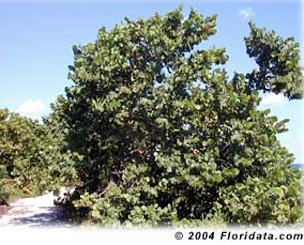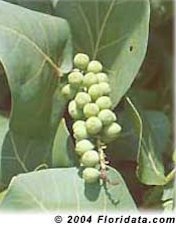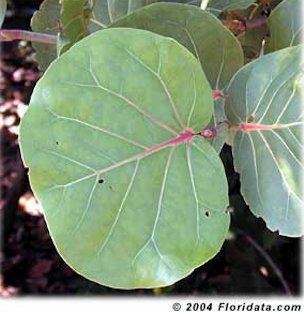From Floridata
by
Steve Christman
Coccoloba uvifera
Common
Names: sea grape
Botanical
Family: Polygonaceae, the buckwheat Family
Description
On
sand dunes and beaches, seagrape usually grows as a diffuse, sprawling
shrub with stout branches and rarely a distinct trunk. However, away
from the constant salt and sand spray it can grow into a handsome
vase-shaped tree up to 50 ft (15.2 m) tall. The shiny, evergreen leaves
are leathery, rounded with heart-shaped bases. The bright green leaves
are often veined in red and are about 8 in (20.3 cm) in diameter. The
fragrant white flowers are very small and borne on 6-10 in (15.2-25.4
cm) spikes. Female trees bear reddish fruits that are about 3/4 in (1.9
cm) in diameter, pear-shaped and fleshy with a hard "stone." They hang
down in grape-like clusters and attract birds and children.

The mature sea grape graces a beach on Key Biscayne, Florida.
Location
Seagrape
is a tropical plant, native to coastal hammocks, coastal scrub, coastal
grasslands and beach strands from Argentina north throughout the West
Indies and the Florida Keys to Pinellas County on the Gulf Coast and
southern Volusia County on the Atlantic Coast of Florida. It does not
reach tree stature at the northern limits of its range.

Culture
Light: Partial shade to full sun
Moisture: Drought tolerant, but water frequently until established.
Hardiness: USDA Zones 10 - 11.
Propagation: By seed or ground-layering.
Usage
Seagrape
is used in hedges and as a street tree in coastal cities throughout the
tropics. It is one of the most commonly used native plants in South
Florida landscaping. Seagrape is highly tolerant of salt spray and
salty soils as well as strong sun and wind. It is often planted as a
windbreak near beaches and as a hedge or barrier around shopping
centers and parking lots. Seagrape makes a fine shade tree in town and
provides that "tropical look near the sea."

The broad, brilliantly veined pingpong paddle leaves of
the seagrape give it a uniquely decorative presence at
the beach and beyond.
Features
The
fruits are edible raw and are made into "seaside jelly" or wine. In the
West Indies, they boil the wood to yield a red dye. Wood from larger
trees is prized for cabinet work. A gum from the bark is used for
throat ailments, and the roots are used to treat dysentery.
|
|